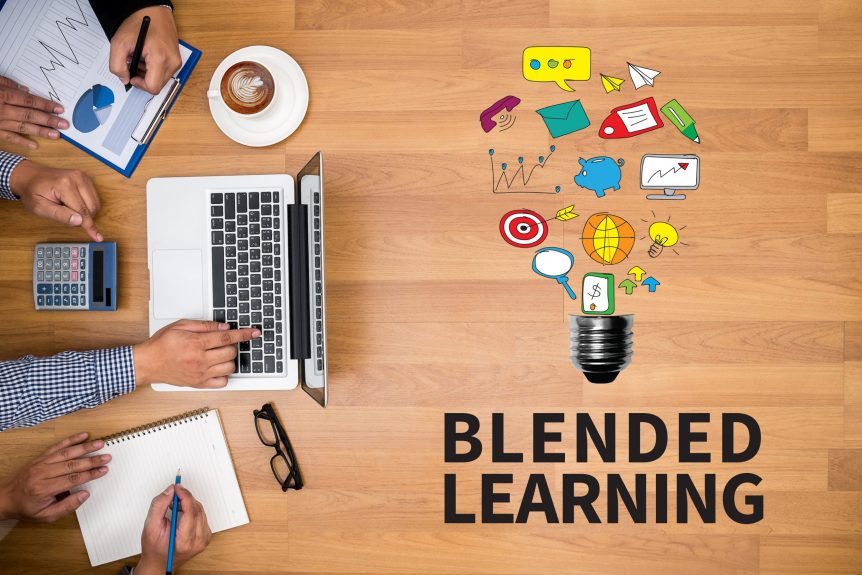7 Different Types of Blending Learning
Blended learning covers any type of course that has both an instructor-led element and an e-learning element. So, you split the course up into different sections, with some parts learned in a more traditional setting with an instructor, while others take place online.
The instructor-led element is often described as classroom-based or face-to-face, but modern technology means this doesn’t always have to be the case. Instead, the instructor-led elements of the course could be video calls, live webinars, or face-to-face at your UAE or Saudi Arabia location.
The technologies that are available make blended learning viable when distances or other barriers prevent learners and instructors from meeting in the same physical location.
The above description of blended learning only scratches the surface of the many variations that are possible. Here are seven of the most common types of blended learning.
Supplemented Online
This model of blended learning involves mostly e-learning content, with occasional instructor-led classes. Those instructor-led elements can take place at any time. For example, the instructor-led element could be at the start of the process, introducing learners to the topic. Learners then continue their learning with e-learning modules.
Rotational
With this blended learning model, the learning experience involves a reasonably balanced amount of live instructor-led learning and e-learning. It is often used in situations where learners need more practical help and support. That support is provided by the instructor, who often teaches the content with learners then using the e-learning elements of the course to reinforce that teaching.
Individual Rotation
This model of blended learning is similar to the above, except that each learner pathway is personalised. In the above model, all learners take part in the instructor-led elements together, and they complete all the e-learning elements. In other words, they all do the same thing.
With the individual rotation blended learning model, learners attend instructor-led sessions based on their personal needs. The same applies to e-learning elements.
A good example of this blended learning model is a learning topic that needs to be completed by everyone in the organisation. However, some elements will be applicable to some learners but not to others. For example, staff in one department could complete content sections A, B, C, and E, while staff in another department will complete A, B, and D.
The personalisation can go even deeper, with software personalising the learning experience on an individual basis, based not only on things like department or role, but also on capabilities and knowledge.
Flexible
The flexible blended learning model is one of the most fluid. As with the supplemented online model, you deliver most of the content with e-learning modules. Then, rather than the instructor leading formalised training sessions where there is a set date and time, they offer their support as and when required.
That support could be to an individual, a small group of learners, or to everyone completing the course if that is appropriate. The key point is the support provided by the instructor is live and interactive, whether that is physically in a classroom or virtually on a video call.
Supplemented Face-to-Face
The supplemented face-to-face blended learning model is the opposite of the supplemented online model. In other words, most of the course is face-to-face with the instructor. The e-learning elements of the course supplement the instructor’s activities through reinforcement, practice, and additional material.
Training on a new machine is a good example, where most of the training is instructor-led, with the instructor covering all aspects of the course. The e-learning elements can then reinforce what has been learned, such as an e-learning module reinforcing the safety processes and how to use the machine safely.
Flipped Classroom
In a traditional classroom-based training scenario, learning takes place in the classroom. Learners are then provided with materials that they use outside the classroom to help reinforce what they have learned.
In the flipped classroom, all the learning takes place online through e-learning modules and content. Learners then attend instructor-led sessions to reinforce what they have learned through the online content.
For example, an instructor could provide context or examples, or they could answer any questions or queries the learners have, with the aim of helping learners achieve a deeper level of understanding.
This blended learning model can be highly effective in situations where learners have strong self-motivation levels and a strong desire to learn the content.
Self-Directed
The self-directed blended learning model involves teaching almost everything in instructor-led sessions. However, this model takes into account the fact that some learners will be better than others, with some wanting to achieve more than the minimum required in the face-to-face sessions.
Self-directed blended learning does this by making additional e-learning content available to those who want it. The additional e-learning content can explain concepts in more detail, it can delve into related topics, or it can provide learners with additional opportunities to practice what they have learned.
It is an approach that is about more than offering learners additional resources that they can use for further study. Instead, it is structured, with carefully created e-learning content that connects with the main topic of the course and the overall training objective.
Adapting a Blended Learning Model that Best Suits Your Needs
Within each of the types of blended learning on this list, there are countless variations that are possible. This fact demonstrates one of the biggest advantages of blended learning – its flexibility. In other words, you can adapt any of the models above according to the needs of your organisation.
The result will be courses and learning content that deliver a better learning experience and ensures you achieve your goals.
